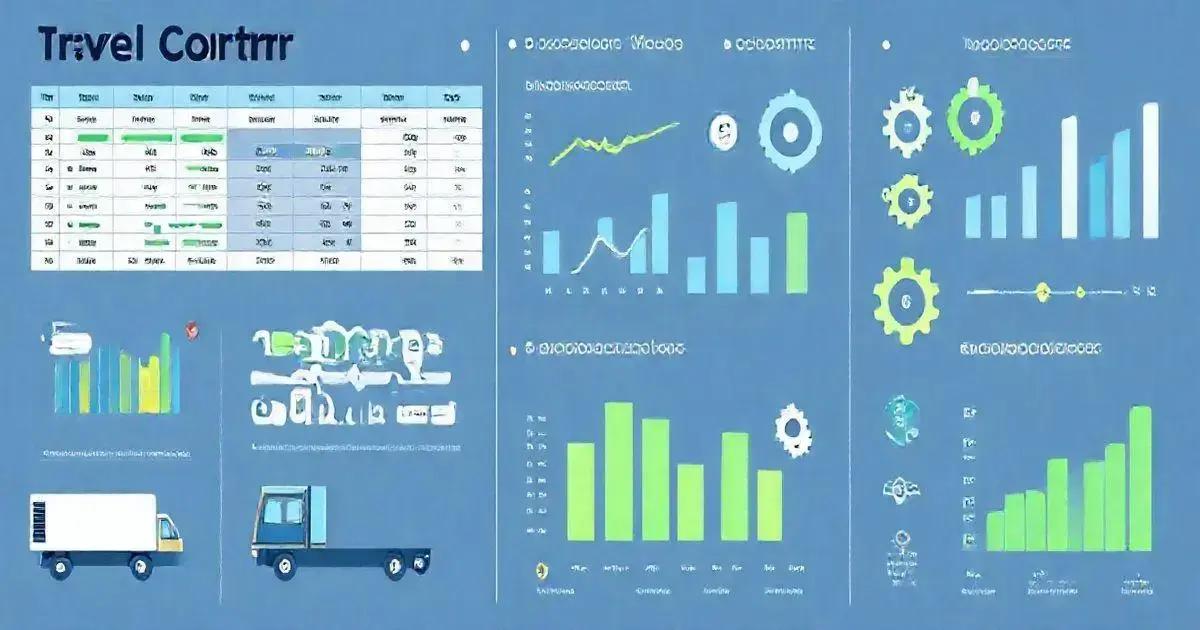Discover the All-New Fleet Control Worksheet 7.0 Leave a comment
The Fleet Control Worksheet 7.0 is a vital tool for fleet management, offering features like performance dashboards, driver and vehicle registrations, document management, cargo tracking, and maintenance monitoring, all aimed at enhancing operational efficiency, safety, compliance, and profitability.
The Fleet Control Worksheet 7.0 is the ultimate tool for logistics managers and fleet operators. This spreadsheet template offers comprehensive features for tracking vehicle performance, fuel consumption, maintenance schedules, and costs.
Whether you are managing a small business or a large fleet, this tool provides functionalities tailored to meet your operational needs.
Initial Dashboards
The Fleet Control Worksheet 7.0 features several initial dashboards designed to provide a quick overview of your fleet’s performance and operational efficiency. These dashboards are essential for making informed decisions and optimizing fleet management.
Initial Dashboards
- KM by Driver: This dashboard displays the total kilometers driven by each driver, allowing you to assess their performance and efficiency.
- KM per Vehicle: Here, you can track the total kilometers traveled by each vehicle in your fleet, helping you maintain vehicle health and optimize usage.
- KM per Liter: This metric provides insights into fuel consumption by calculating the distance traveled per liter of fuel, crucial for managing fuel costs.
- KM per Trip: Monitor the distance covered during each trip, enabling you to evaluate route efficiency and trip planning.
- Average Consumption per Vehicle: This dashboard summarizes the average fuel consumption for each vehicle, helping identify which vehicles may require maintenance or optimization.
- Average Consumption per Driver: Similar to vehicle consumption, this metric helps assess fuel efficiency on a driver basis, providing insights into driving habits.
- Total General Maintenance: Keep track of all maintenance performed on your fleet, both preventive and corrective, to ensure vehicle reliability.
- Maintenance Cost Average: This section calculates the average cost of maintenance per vehicle, assisting in budget adjustments and cost management.
- Total cost of Mechanical and Electrical Maintenance: Get a consolidated view of all expenses related to mechanical and electrical repairs, aiding in financial planning.
- Total Tire Maintenance Cost: Understand the overall costs associated with tire maintenance, which is vital for operational budgets.
- Total Lubricant Cost: Track lubricant expenses to ensure proper vehicle maintenance and operational efficiency.
- Average cost of Mechanical and Electrical Maintenance: Get insights into average repair costs, helping in financial forecasting.
- Average Tire Maintenance Cost: This metric evaluates the average costs associated with tire upkeep, guiding purchasing decisions.
- Average cost with Lubricants: Analyze lubricant expenses over time to optimize purchasing strategies.
- Vehicles in Transit: Monitor how many vehicles are currently on the road, facilitating better logistics management.
- Tires in Transit: Keep track of tire replacements or services that are in progress, ensuring timely follow-ups.
- Delayed Vehicle Documents: Manage compliance by tracking any vehicle documents that are overdue, ensuring all paperwork is up-to-date.
- Delayed Driver Documents: Similar to vehicle documents, this dashboard alerts you to any delays in obtaining or renewing driver documentation.
- Delayed Preventive Maintenance: This section highlights any overdue preventive maintenance tasks, crucial for maintaining fleet safety and efficiency.
- Total Cost Versus Shipping: Analyze whether your total operational costs align with your shipping revenue, providing insights into profitability.
- Fuel, Maintenance and Other Costs: This dashboard aggregates all operational costs including fuel and maintenance, aiding in comprehensive budget assessments.
By utilizing these dashboards, fleet managers can gain a holistic view of their operations, enabling data-driven decisions that enhance efficiency and cut costs.

Registrations
The Fleet Control Worksheet 7.0 includes comprehensive registration sections that are essential for maintaining detailed records of your fleet operations. Accurate registrations help ensure compliance and aid in effective fleet management. Here’s a breakdown of the key registrations included:
Registrations
- Driver Registration: This section allows you to record essential information about each driver, such as name, contact details, license number, and any special qualifications. Keeping this information updated is crucial for compliance and safety.
- Vehicle Type Registration: Document the various types of vehicles in your fleet, including make, model, year, and specifications. This helps in managing and monitoring vehicle performance effectively.
- Mechanical and Electrical Services Registry: Track all mechanical and electrical services performed on your vehicles. This includes repairs, parts replacements, and service history, ensuring that your fleet operates smoothly.
- Tree Service Registration: This unique feature allows you to record tree service details, which can be particularly useful for businesses that manage vehicle fleets involved in landscaping or environmental services.
- Lubricant Services Register: Maintain records of all lubricant services, including the type and frequency of lubricants used. This is key to ensuring vehicle longevity and optimal performance.
- Register of Workshops and Suppliers: Keep an updated list of trusted workshops and suppliers for parts and services. This helps streamline maintenance processes and ensures reliability in your supply chain.
- Expenditure Type Register: Categorize different types of expenditures related to fleet operations, such as fuel, maintenance, and repairs. This provides clarity on spending patterns and aids in budgeting.
- Refueling Station Registration: Document the locations of refueling stations used by the fleet, including contact details and operating hours. This information is invaluable for planning fuel stops on long trips.
- Fuel Type Register: Keep track of the different types of fuels used across your fleet, ensuring compatibility with vehicle specifications and helping in cost management.
By maintaining accurate registrations, fleet managers can enhance operational efficiency, ensure compliance with regulations, and optimize resource allocation across their fleet.
Document Management
Effective Document Management is critical for fleet operations, and the Fleet Control Worksheet 7.0 provides a structured approach to ensure all necessary documents are tracked and maintained. This section focuses on the management of important documents associated with both drivers and vehicles, facilitating compliance and operational efficiency.
Document Management
- Driver Document Control: This feature allows fleet managers to track all relevant documentation for each driver, including:
- Driver’s license: Ensure each driver’s license is valid and up-to-date.
- Certification and training documents: Keep records of any certifications or training that drivers have completed, ensuring they meet safety and operational standards.
- Medical examinations: Monitor medical certificates necessary for drivers, ensuring compliance with health regulations.
- Vehicle Document Control: Similar to driver documents, this section helps manage all vehicle-related documentation, including:
- Registration documents: Track the registration status of each vehicle in the fleet to avoid legal issues.
- Insurance papers: Maintain current insurance details for all vehicles, ensuring coverage is adequate and renewed on time.
- Inspection certificates: Keep records of routine inspections and maintenance checks, ensuring vehicles are safe for operation.
By implementing a robust document management system, fleet operators can ensure all necessary records are easily accessible, reducing the risk of compliance issues and improving overall fleet management efficiency.

Travel Control
Travel control is a vital component of fleet management, and the Fleet Control Worksheet 7.0 offers comprehensive features to manage and monitor all travel-related activities. This section helps fleet managers keep track of trips, cargo, and expenses associated with travel.
Travel Control Features
- Cargo Control Linked to Trips: This feature allows you to document and manage the cargo associated with each trip. It ensures that all items transported are accounted for and helps prevent loss or mismanagement of goods.
- Vehicle Control: Keep track of which vehicles are assigned to which trips. This helps in optimizing vehicle usage and reduces the chances of unauthorized use.
- Driver Control: Monitor which drivers are assigned to specific trips, ensuring accountability and facilitating easy communication during travel.
- Supply Control: Manage supplies needed for each trip, such as fuel, maintenance supplies, and refreshments. This ensures that all resources are available and accounted for before departure.
- Control of All Travel Expenses: This section allows fleet managers to log and manage all expenses related to travel, including fuel costs, tolls, and any other incidentals. Keeping track of these expenses is essential for budgeting and financial reporting.
By effectively managing travel control, fleet operators can enhance operational efficiency, reduce costs, and ensure that all trips are conducted smoothly and within budget.
Tire Control
Tire management is crucial for maintaining the safety, efficiency, and performance of your fleet. The Fleet Control Worksheet 7.0 provides a comprehensive tire control section designed to help fleet managers monitor and manage all aspects related to tire usage and maintenance.
Tire Control
- Identification for Each Tire: This feature allows you to assign unique identifiers to each tire in your fleet. Keeping track of individual tires helps in monitoring performance and wear patterns.
- Tire Change Schedule by KM: Set up a scheduled maintenance plan for tire changes based on distance traveled (KM). This proactive approach helps ensure that tires are replaced before they become unsafe or inefficient.
- Signal of How Much KM is Left to Change the Tire: The system provides alerts and reminders indicating the remaining distance before the next tire change is due, helping to ensure timely replacements.
- Status per Action: Monitor the status of each tire regarding its current action, such as:
- Allocate to Vehicle: Keep track of which vehicle each tire is currently assigned to.
- Remove from Vehicle: Document when a tire is taken off a vehicle, whether for maintenance or replacement.
- Scrap: Manage tires that are no longer usable, ensuring proper disposal and compliance with regulations.
- Maintenance: Record any maintenance activities performed on tires, such as rotation or inflation checks.
By effectively managing tire control, fleet managers can extend the life of tires, enhance safety, and reduce costs associated with tire replacements and maintenance. This comprehensive approach ensures that the fleet remains efficient and capable of meeting operational demands.

Maintenance Control
Maintenance control is a critical aspect of fleet management, ensuring that vehicles are safe, efficient, and reliable. The Fleet Control Worksheet 7.0 offers robust features to manage and track all maintenance activities, helping fleet managers maintain optimal vehicle performance.
Maintenance Control
- Corrective and Preventive Maintenance Type: This section allows fleet managers to categorize maintenance tasks into corrective and preventive actions. Corrective maintenance addresses existing issues, while preventive maintenance aims to prevent potential problems before they arise.
- Maintenance by Vehicle: Track maintenance activities on a per-vehicle basis, providing insights into which vehicles are requiring more frequent attention. This helps in identifying potential issues and optimizing maintenance schedules.
- Maintenance by Mechanical and Electrical Type, Tire and Lubricants: Document various types of maintenance performed, whether mechanical, electrical, tire-related, or lubricants. This comprehensive overview helps managers understand the distribution of maintenance efforts across different vehicle systems.
- Maintenance Cost: Monitor the costs associated with maintenance activities, enabling fleet managers to budget effectively and identify cost-saving opportunities. Keeping track of these expenses ensures that funding is adequately allocated.
- Preventive Maintenance Schedule: Set up a schedule for regular preventive maintenance tasks, such as oil changes, tire rotations, and inspections. This proactive approach helps in minimizing downtime and extends the life of the vehicles.
- Preventive Maintenance Signal: Utilize alerts and reminders for upcoming preventive maintenance tasks, ensuring that they are not overlooked and are performed on time.
- Status by: Track the status of maintenance tasks to determine whether they are scheduled, accomplished, or delayed. Monitoring these statuses helps fleet managers stay on top of maintenance schedules and make informed decisions regarding vehicle availability.
By implementing effective maintenance control, fleet operators can enhance vehicle reliability, reduce operational costs, and ensure that their fleet remains compliant with safety and regulatory standards.
Conclusion
In conclusion, the Fleet Control Worksheet 7.0 is an invaluable tool for fleet managers looking to enhance operational efficiency and maintain high standards of vehicle performance.
With features tailored for comprehensive travel control, tire management, and rigorous maintenance oversight, this worksheet empowers users to make data-driven decisions that optimize resources and reduce costs.
By leveraging the various dashboards and management functionalities, fleet operators can ensure that all aspects of fleet management are meticulously tracked and maintained.
From monitoring driver registrations to controlling travel expenses and overseeing tire usage, this worksheet consolidates vital information in one accessible platform.
Ultimately, adopting the Fleet Control Worksheet 7.0 will not only help streamline operations but also contribute to improved safety, compliance, and profitability in fleet management.
FAQ – Frequently Asked Questions about Fleet Control Worksheet 7.0
What features does the Fleet Control Worksheet 7.0 include?
The Fleet Control Worksheet 7.0 includes features for travel control, tire management, maintenance tracking, driver registrations, and detailed dashboards for monitoring fleet performance.
Is the Fleet Control Worksheet compatible with all versions of Excel?
Yes, the Fleet Control Worksheet 7.0 works on any version of Excel, including Excel 2007, 2010, 2013, and 2016.
Can I use the Fleet Control Worksheet for multiple vehicles?
Absolutely! The worksheet is designed to manage and track multiple vehicles, making it ideal for fleets of any size.
How can I ensure timely maintenance for my fleet?
The worksheet includes a preventive maintenance schedule feature that alerts you when maintenance tasks are due, helping to keep your vehicles in optimal condition.
Is technical support available if I encounter issues with the worksheet?
Yes, technical support is available from Monday to Friday, and assistance can be provided via email or WhatsApp.
Can I customize the Fleet Control Worksheet for my specific needs?
While the worksheet is comprehensive, specific customization requests may require additional development and are not included in the standard package.

